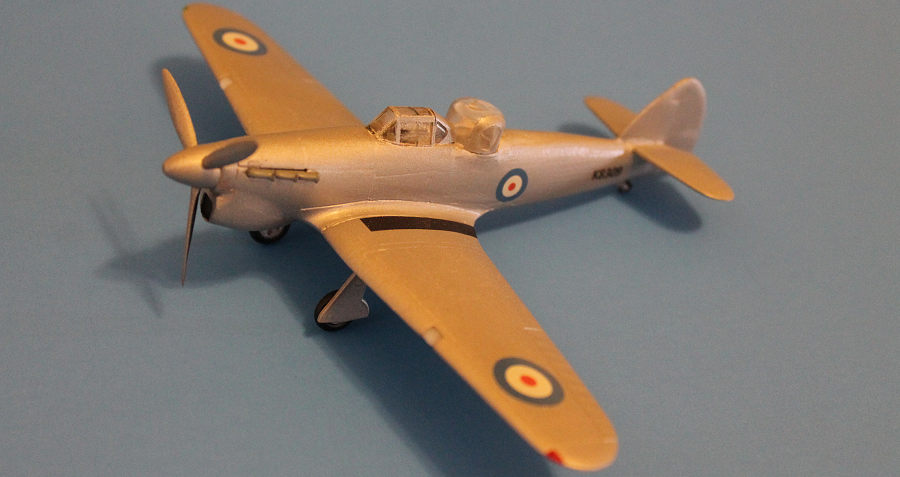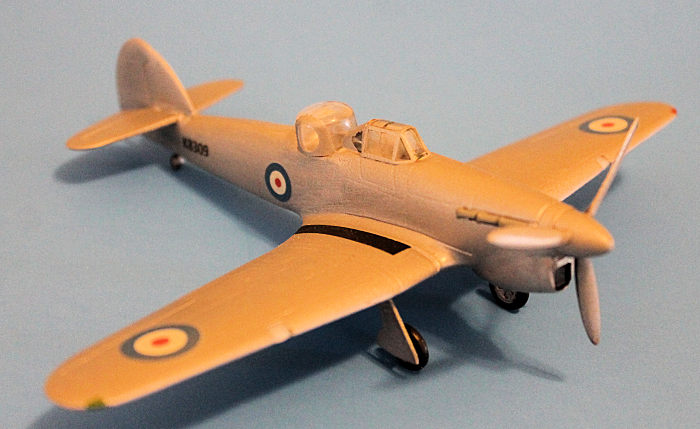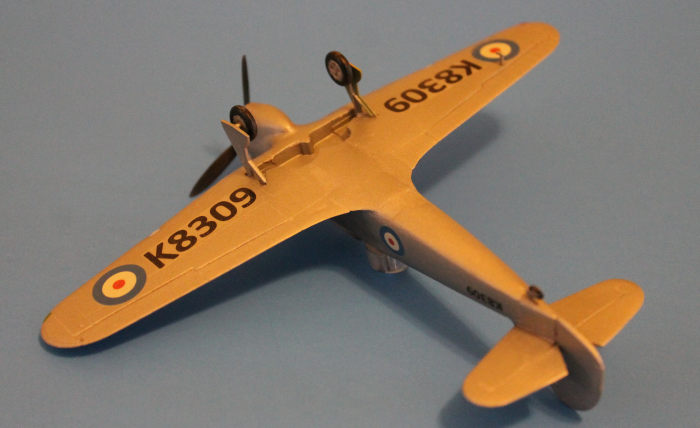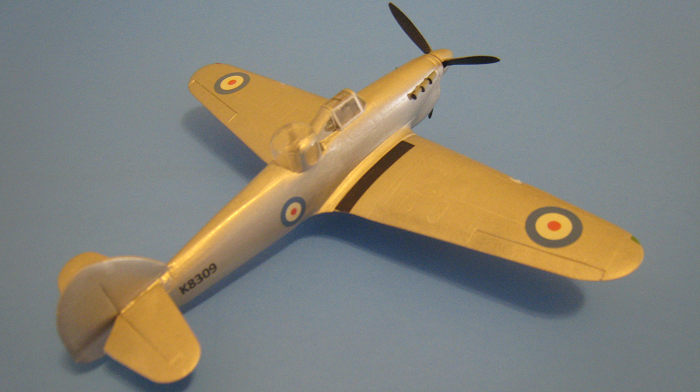
Matchbox 1/72 Hawker Hotspur
| KIT #: | PK-11 |
| PRICE: | $ |
| DECALS: | one option |
| REVIEWER: | Brian Baker |
| NOTES: | Conversion |

| HISTORY |
In 1935, the RAFís leaders
decided to seek a replacement for the two seat Hawker Demon fighter, and
basically, there were two contenders, Boulton and Paul, who had developed a four
gun .303 armed power turret small enough to be installed on a fighter airframe,
and Hawker, who was developing the Hurricane single seat fighter and who had gone on to develop a two seat light bomber, known as the Henley.
Hawker used a Hurricane airframe as the basis for their conversion, and after
significant modifications, emerged with a Boulton Paul turreted version, which
they named the Hotspur.
and who had gone on to develop a two seat light bomber, known as the Henley.
Hawker used a Hurricane airframe as the basis for their conversion, and after
significant modifications, emerged with a Boulton Paul turreted version, which
they named the Hotspur.
The RAF specification, F.9/35, called for a two place interceptor, and the original prototype flew on June 14, 1938, with a wooden mockup of the power turret. Powered by a Rolls Royce Merlin of 1,030 hp., the plane had a maximum speed of 316 mph, slightly faster than the Boulton Paul Defiant, and had no forward firing wing mounted armament. The pilotís job, apparently, was to maneuver in such a way as to give the turret gunner a good shot at the enemy aircraft. Dimensions were similar to those of the Hurricane, and after initial test flights, it was decided to continue development of the Defiant, as Hawker was just beginning to produce the Hurricane in large numbers, and the Hurricane was thought to be much more important at that time. Eventually, the Hotspur prototype was abandoned, resulting in large scale production of the Defiant, which proved to be a disappointment for the RAF. Only one Hotspur fighter was built, and the name eventually was re-assigned to the Airspeed training glider.
| THE KIT |
Since the aircraft was so closely related to the Hurricane, I used a Hurricane kit from Matchbox for the conversion. The Hurricane kit has been reviewed many times, so for the basics, I would refer you to kit reviews of Matchboxís PK-11 kit review. It probably isnít the best and most detailed kit on the market, and certainly is no longer in production, but it is basically accurate in outline and certainly a relatively easy conversion to either a Hotspur or Henley aircraft. There are some parts that need to be modified or replaced, but nothing that requires major surgery.
| CONSTRUCTION |
 I began
construction by removing all of the major parts from the sprues, and trimming
off the joining scrap. This model was constructed back in 2015, so I hope I can
remember all of the details. Major parts requiring no real changes included the
wings, which only required removal of evidence of wing armament, as the Hotspur
had none. The elevators needed replacements, as they werenít exactly the right
shape, and I took these from my spares box, although I donít know what kit they
were taken from. The fuselage required some major surgery, however. Forward, the
plane has a large scoop which houses the radiator under the nose, whereas the
Hurricaneís unit is under the trailing edges of the wing. The rear fuselage
needs to be cut down, and rounded out, as the turret required some clearance for
the machine guns. This section then needs to be filled in and finished after the
fuselage halves are joined. The pilotís canopy is slightly smaller than that of
the Hurricane, and the one I used was fairly thick, making it impossible to see
much of the cockpit interior. I put in a pilotís seat and instrument panel, but
they are not visible through the canopy. I used a turret from my scrap box, but
I donít know what model it came from. It is approximately the correct shape, and
since there were no interior details, installing it was a snap. There is no
detail in the rear gun turret, mainly because on the real airplane, it was only
a wooden mockup, so my model has no turret interior detail. The rudder is
slightly larger than that of a Hurricane, so I had to extend both the fin and
the rudder using putty, but this turned out to be a relatively simple job. Since
the whole airplane is silver, I assembled the rest of the parts, including the
new elevators, landing gear, gear doors, and tailwheel. I masked off the windows
on the main canopy and the turret. I then added the propeller after painting the
rear surfaces of the blades black and applied masking tape to them. Now the
plane was ready for painting.
I began
construction by removing all of the major parts from the sprues, and trimming
off the joining scrap. This model was constructed back in 2015, so I hope I can
remember all of the details. Major parts requiring no real changes included the
wings, which only required removal of evidence of wing armament, as the Hotspur
had none. The elevators needed replacements, as they werenít exactly the right
shape, and I took these from my spares box, although I donít know what kit they
were taken from. The fuselage required some major surgery, however. Forward, the
plane has a large scoop which houses the radiator under the nose, whereas the
Hurricaneís unit is under the trailing edges of the wing. The rear fuselage
needs to be cut down, and rounded out, as the turret required some clearance for
the machine guns. This section then needs to be filled in and finished after the
fuselage halves are joined. The pilotís canopy is slightly smaller than that of
the Hurricane, and the one I used was fairly thick, making it impossible to see
much of the cockpit interior. I put in a pilotís seat and instrument panel, but
they are not visible through the canopy. I used a turret from my scrap box, but
I donít know what model it came from. It is approximately the correct shape, and
since there were no interior details, installing it was a snap. There is no
detail in the rear gun turret, mainly because on the real airplane, it was only
a wooden mockup, so my model has no turret interior detail. The rudder is
slightly larger than that of a Hurricane, so I had to extend both the fin and
the rudder using putty, but this turned out to be a relatively simple job. Since
the whole airplane is silver, I assembled the rest of the parts, including the
new elevators, landing gear, gear doors, and tailwheel. I masked off the windows
on the main canopy and the turret. I then added the propeller after painting the
rear surfaces of the blades black and applied masking tape to them. Now the
plane was ready for painting.
| COLORS & MARKINGS |
 One thing
about this airplane was that it had an aluminum finish, meaning that all
surfaces were silver, including the wheel wells and landing gear. I masked off
the canopy windows, and gave it several coats of aluminum enamel. I then painted
the radiator intake on the scoop black, and constructed the decals. The plane
had no tail stripes, only roundels, and these came from the spares box. There
were four serial number displays, two on the rear fuselage sides and two on the
wing undersides, reversed in typical RAF fashion. I made the number decals on my
computer, and they worked very well. I used two strips of black decals for the
wing walks, and that was about it.
One thing
about this airplane was that it had an aluminum finish, meaning that all
surfaces were silver, including the wheel wells and landing gear. I masked off
the canopy windows, and gave it several coats of aluminum enamel. I then painted
the radiator intake on the scoop black, and constructed the decals. The plane
had no tail stripes, only roundels, and these came from the spares box. There
were four serial number displays, two on the rear fuselage sides and two on the
wing undersides, reversed in typical RAF fashion. I made the number decals on my
computer, and they worked very well. I used two strips of black decals for the
wing walks, and that was about it.
| CONCLUSIONS |
I think that the essence of a good model collection is the variety of aircraft presented. You can build lots of Spitfires, Hurricanes, Messerschmitts, Focke Wulfs, Mustangs and Lightnings, but to produce some of the more unusual variants takes some ingenuity, but the information is available, and if you can find it, you can build some of the one-offs that make a model collection interesting. Of course, on your display, you should identify each model and indicate what is different about it, and this allows the viewer to walk away saying ďI learned something from that.Ē I had a lot of fun with this model, and Iíll do a few more RAF experimental types in the near future. Try one.
| REFERENCES |
There is really very little information available on the Hotspur, and the best source Iíve found is the book Fighters, by famous authors William Green and Gordon Swanborough, MBI Publishing Co., Osceola, WI, 1994, ISBN # 0-7603-1194-3. This book has information on virtually every fighter plane ever built or flown up to publication date, and should be on every serious modelerís bookshelf. In addition, most aircraft described have three view drawings alongside the descriptions.
4 July 2022 Copyright ModelingMadness.com. All rights reserved. No
reproduction in part or in whole without express permission. If you would like your product reviewed fairly and
fairly quickly, please
contact
the editor or see other details in the
Note to
Contributors.